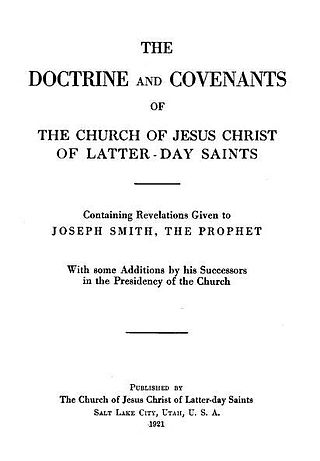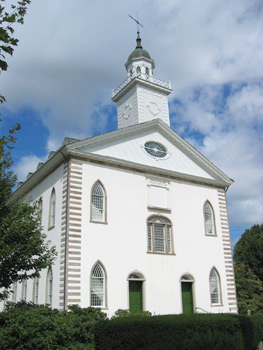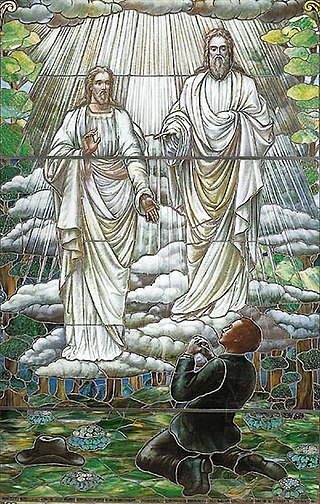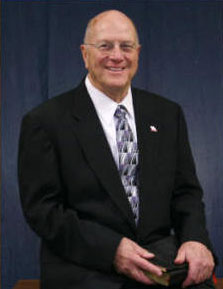
The Doctrine and Covenants is a part of the open scriptural canon of several denominations of the Latter Day Saint movement. Originally published in 1835 as Doctrine and Covenants of the Church of the Latter Day Saints: Carefully Selected from the Revelations of God, editions of the book continue to be printed mainly by the Church of Jesus Christ of Latter-day Saints and the Community of Christ.

Community of Christ, known from 1872 to 2001 as the Reorganized Church of Jesus Christ of Latter Day Saints (RLDS), is an American-based international church, and is the second-largest denomination in the Latter Day Saint movement. The church reports approximately 250,000 members in 1,100 congregations in 59 countries. The church traces its origins to Joseph Smith's establishment of the Church of Christ on April 6, 1830. His eldest son Joseph Smith III formally accepted leadership of the church on April 6, 1860 in the aftermath of the 1844 death of Joseph Smith.
In the Latter Day Saint movement, priesthood is the power and authority of God given to man, including the authority to perform ordinances and to act as a leader in the church. A group of priesthood holders is referred to as a quorum.

In the Latter Day Saint movement, an ordinance is a sacred rite or ceremony that has spiritual and symbolic meanings and act as a means of conveying divine grace. Ordinances are physical acts which signify or symbolize an underlying spiritual act; for some ordinances, the spiritual act is the finalization of a covenant between the ordinance recipient and God.
In the Latter Day Saint movement, the President of the Church is generally considered to be the highest office of the church. It was the office held by Joseph Smith, founder of the movement, and the office assumed by many of Smith's claimed successors, such as Brigham Young, Joseph Smith III, Sidney Rigdon, and James Strang. Several other titles have been associated with this office, including First Elder of the church, Presiding High Priest, President of the High Priesthood, Trustee-in-Trust for the church, Prophet, Seer, Revelator, and Translator. Joseph Smith was known by all of these titles in his lifetime.

The Aaronic priesthood is the lesser of the two orders of priesthood recognized in the Latter Day Saint movement. The higher being the Melchizedek priesthood. Unlike the Melchizedek priesthood, which is modeled after the authority of Jesus and the Twelve Apostles, the Aaronic priesthood is modeled after the priesthood of Aaron the Levite, the first high priest of the Hebrews, and his descendants. The Aaronic priesthood is thought to be a lesser or preparatory priesthood and an "appendage" of the more powerful Melchizedek priesthood.

The Church of Christ, informally called Hedrickites and the Church of Christ (Temple Lot), is a denomination of the Latter Day Saint movement headquartered in Independence, Missouri, on what is known as the Temple Lot. The nickname for members of the church comes from the surname of Granville Hedrick, who was ordained as the church's leader in July 1863. Unlike the Church of Jesus Christ of Latter-day Saints (LDS Church) and Community of Christ, the Temple Lot church rejects the office of prophet or president, being instead led by its Quorum of Twelve Apostles. The church also rejects the doctrines of baptism for the dead and celestial marriage promulgated by the Utah-based LDS Church, as well as the Doctrine and Covenants and Pearl of Great Price. While once avidly engaged in dialogue with other Latter Day Saint factions, the church no longer has any official contact with any other organization. It is notable for its sole ownership of the Temple Lot, which it has held for nearly 150 years. As of 2013, membership is 7,310 members in 11 countries. Most of the members live in the United States, but there are parishes in Canada, Mexico, Honduras, Nigeria, Kenya, Democratic Republic of the Congo, Malawi, Tanzania, India, Ethiopia, and the Philippines.

The Church of Christ was the original name of the Latter Day Saint church founded by Joseph Smith. Organized informally in 1829 in upstate New York and then formally on April 6, 1830, it was the first organization to implement the principles found in Smith's newly published Book of Mormon, and thus its establishment represents the formal beginning of the Latter Day Saint movement. Later names for this organization included the Church of the Latter Day Saints, the Church of Jesus Christ, the Church of God, the Church of Christ of Latter Day Saints, and the Church of Jesus Christ of Latter Day Saints.
Priest is a priesthood office in the Aaronic priesthood of denominations within the Latter Day Saint movement, including the Church of Jesus Christ of Latter-day Saints.

William Marks was an early leader in the Latter Day Saint movement and was a member of the First Presidency in the Reorganized Church of Jesus Christ of Latter Day Saints. Marks is mentioned in the Doctrine and Covenants in sections 117 and 124 of the Church of Jesus Christ of Latter-day Saints edition and in section 115 of the Community of Christ edition.
In the Latter Day Saint movement, patriarch is an office of the priesthood. It is considered to be either an office of the patriarchal priesthood or the Melchizedek priesthood.

The Remnant Church of Jesus Christ of Latter Day Saints, usually referred to as the Remnant Church, is a denomination in the Latter Day Saint movement. The prophet / president of the church is Terry W. Patience.
Elder is a priesthood office in the Melchizedek priesthood of denominations within the Latter Day Saint movement, including The Church of Jesus Christ of Latter-day Saints.

The history of Community of Christ, formerly known as the Reorganized Church of Jesus Christ of Latter Day Saints, covers a period of approximately 200 years. The church's early history traces to the "grove experience" of Joseph Smith, who prayed in the woods near his home in Palmyra, New York, in the early-19th century. Several accounts of this experience have surfaced over the years. Most of the accounts share a common narrative indicating that when he went to the woods to pray, he experienced a period of encountering evil or despair, but then experienced an epiphany or vision in which he came to know and understand God's goodness. Later, as an adult, Smith founded the Church of Christ on April 6, 1830.

Community of Christ and the Church of Jesus Christ of Latter-day Saints are two denominations that share a common heritage in the Church of Christ founded by Joseph Smith on April 6, 1830. Since Smith's death in 1844, they have evolved separately in belief and practices. The Church of Jesus Christ of Latter Day Saints is headquartered in Salt Lake City, Utah, and claims more than 17 million members worldwide; Community of Christ is headquartered in Independence, Missouri, and reports a worldwide membership of approximately 250,000.
In the Church of Jesus Christ of Latter-day Saints, the priesthood is the power and authority to act in the name of God for the salvation of humankind. Male members of the church who meet standards of worthy behavior and church participation are generally ordained to specific offices within the priesthood.

The Church of Jesus Christ of Latter-day Saints focuses its doctrine and teaching on Jesus Christ; that he was the Son of God, born of Mary, lived a perfect life, performed miracles, bled from every pore in the Garden of Gethsemane, died on the cross, rose on the third day, appeared again to his disciples, and now resides, authoritatively, on the right hand side of God. In brief, some beliefs are in common with Catholics, Orthodox and Protestant traditions. However, teachings of the LDS Church differ significantly in other ways and encompass a broad set of doctrines, so that the above-mentioned denominations usually place the LDS Church outside the bounds of orthodox Christian teaching as summarized in the Nicene Creed.

The Church of Jesus Christ (Zion's Branch) is a denomination of the Latter Day Saint movement headquartered in Independence, Missouri. It was formed on April 6, 1985 by individuals who had separated from the Reorganized Church of Jesus Christ of Latter Day Saints, now the Community of Christ, due to certain doctrinal changes which took place in this organization during the 1970s and 80s, culminating in the adoption of Section 156 of the RLDS Doctrine and Covenants, which allowed women to be ordained to the priesthood. Unable to accept this or other doctrinal changes, a group of elders and members led by A.J. Cato, Robert Hall, Dennis Cato, Noel Goldsmith, Roger E Billings and Lloyd Cunningham, among others, formed Zion's Branch as a separate church. This organization no longer maintains a website, but despite this, many still claim to be proud members of the group. The meetinghouse was sold in April 2019 and is currently being repurposed.

Frederick Niels Larsen was the President of the High Priesthood of the Remnant Church of Jesus Christ of Latter Day Saints and the great grandson of Joseph Smith III.













